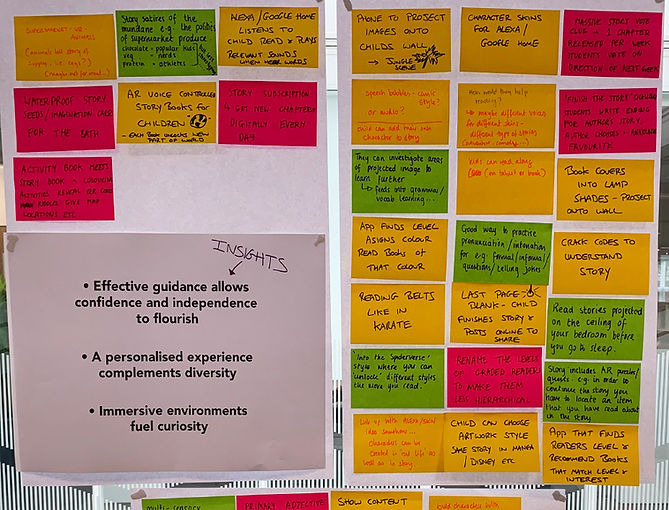

IDEATION
When you start to generate ideas it is important to get comfortable with divergent thinking. You may think, if you land on a solid idea, why should you keep generating more possible solutions? Shouldn’t you just stop when you’ve come up with something good?
Some of the most brilliant ideas come when you fight the urge to stop on an early solution and embrace the discomfort that comes from exploring more. Divergent thinking invites you to play longer and stretch beyond your early ideas.
But isn't work the opposite of play?
People often think that play does not belong in the office, but I believe that the opposite of play is boredom. For ideas to flow people need to be in a safe, fun environment.
So the mindset for ideation is to be playful, ideation is all about coming up with lots and lots of ideas quickly.
If you have a challenge or question you’re working on, ideation is about exploring options to answer that question.
A key to ideation is to give yourself tight time limits, deadlines are motivating and help focus the creative process.
In the 30 circles exercise below you may come up with some brilliant ideas and some that are ridiculous, in early ideation it is often hard to tell the difference.
Coming up with lots of ideas is referred to as divergent thinking, it’s all about quantity.
Start with 30 circles...
Starting with 30 circles on a page and using just a few lines either inside or outside the circle, create as many identifiable objects as you can in just 3 minutes.
When doing this activity, many people have more ideas than they put down because they think they are silly, remember that this exercise is not about judging ideas. People often draw several of the same thing like sports balls, this is a natural place to start and helps you get fluent with your ideas but flexibility and thinking outside the lines is important to.
So try to diverge, stretching beyond your first few ideas, don’t worry if something seems silly, embrace your playful mindset. Here is an example to get you going.

– Source: Ideas to action IDEO-U
Diverge, converge and do it again...
Once you have generated lots and lots of ideas, it is time to change from divergent thinking to convergent thinking. Converging is about looking at all your ideas and deciding which ones to move forward with. It is very common to diverge and converge several times throughout a project as you refine and strengthen your ideas.

Remember Ideation is a team sport, it helps to have diverse perspectives when you are diverging. If you are working alone, find ways to pull people in, anyone can help with ideation.
Try to diverge a bit longer, this is the part people often find hard. Stay in the mindset, keep going, give yourself space to exercise your divergent muscles and keep your urge to converge and judge at bay. It is not time for decision making yet, stay playful.
Methods to help you generate ideas...
When people think of ways to ideate they usually jump straight to brainstorming but there are lots of other methods, here are a couple to get you started.
Mash-up: There is nothing like a mash-up to get the ideas flowing. This method is about bringing odd or unexpected things together to spark fresh ideas. For example when designing a more human centred care experience for a hospital, why not try a hospital and a hotel mash-up, resulting in a mini bar in your hospital room filled with lots of healthy food and drinks for the patient and their families.
When trying this on your project make a list of things in and out of your industry, mash them together and see what you get.
Other people’s shoes-storm: Try putting yourself in other people’s shoes so you can see a challenge from multiple perspectives. You can do this by role-playing a scenario or by drawing up a simple storyboard.
For example, if your trying to innovate an experience for an art museum, think about how an 85 year old with mobility challenges might experience it, and then think about how it might be experienced by a couple with a toddler or a group of teenagers that are glued to their mobile devices or even from the tour guides perspective. Moving through the steps of an experience while thinking about a diverse set of needs will help to spark ideas.
In all ideation methods, you want to try and avoid anyone getting too attached to their own ideas and getting to protective over their initial ideas. Ideation is about shared invention, attaching a single person to a single idea hinders collaboration.
So what are the rules...
These are the rules that I use during ideation sessions, you can of course make up your own to suit your participants and your requirements. You could even set these rules at the beginning of your workshop as a team.
-
Defer JUDGMENT! – Deferring judgment is a great way to get people to open up and share their ideas - brainstorming is going well when you hear lots of laughter, even when it is a serious subject. If it’s quiet the team are probably over judging themselves
-
ENCOURAGE Wild IDEAS – There are so many good ideas in the world, but if you really want innovative ideas you have got to push on to the wild and ridiculous stuff that could eventually lead to something brilliant
-
Build on the IDEAS of others – Building on the ideas of others is a great way to increase quantity by working together, one person will say something wild and this will spark an even further out idea from another person
-
Stay FOCUSED on the topic – Be careful of people hijacking your brainstorm, it can be easy to get distracted when so many cool ideas are flying around. Keep your brainstorm challenge up on the wall so you can point at it and get everyone to stay on topic. Brainstorms work best when focused and with a time limit
-
One CONVERSATION at a time – In a brainstorm it is important to engage but not all at the same time. It’s best to share your idea on a post-it or on a list and just give the headline of your idea so everyone can get it easily and quickly move on
-
Be VISUAL – People love doing quick back of the napkin sketches and doodles, sketching is a great way to get your ideas across, later when you get to voting, you will see the ideas with a sketch are often more powerful - Stick figures are totally acceptable
-
Go for QUANTITY – Going for quantity is really central to ideation, if you only have one idea it’s the only one you can go with, but if you come up with a hundred ideas you’ll have that many more options for getting to that great idea - this is the most important rule of all!
Make choices and move forward...
Most of us are good at converging, we make decisions constantly so this mindset is very natural to us.
At this point you will have a long list of ideas or a wall full of post-it notes, hopefully some wild ideas and some sketches. The aim is to use your insights, judgment and intuition to find the 2-3 early ideas you want to take forward and prototype.
Every time that you converge you will uncover new questions to explore, you can then push those couple of ideas more by diverging again.
Most organisations are wired to race towards solutions. One common mistake is that they rule out ideas that are too edgy or too risky but that does not result in the most innovative outcomes. Further out ideas are really important at this point, when brainstorming we differ judgment, when converging it is OK to judge. Put your intuition and expertise to work.
Here are some questions to help you zero in on ideas to carry forward:
WHAT ARE THE IDEAS THAT...
-
You love and are most personally passionate about
-
Resonate with your insights and peoples needs
-
Ideas that are really risky, scary you, and are hard to implement
This criteria helps you judge when you might be on an intriguing edge. You can create your own criteria but these are a good start.
Steps to help you converge
-
VOTE – Give everyone 3-5 votes and ask them to place a sticker on their favourite ideas. Voting on the spot is subtle but a really important tool. Often great ideas never see the light of day because they get lost in the shuffle.
-
CLUSTER – Start looking for similarities between ideas and quickly cluster them together to see if any themes emerge. Sometimes grouping ideas together can make them stronger (Voting can either happen before or after you cluster or both).
-
DISCUSS– The core team should now come back and summarize what came out of the ideation phase and discuss which ideas to prototype. Sharing why you like an idea will help the discussion flow.
-
DECIDE– While you can certainly invite input from others, the final decision belongs to the core team or the team leader. Listen to others, make a call and ensure you move forward. Don’t dismiss an idea just because it seems hard to implement – prototyping and iteration can turn it into a viable solution.

– Source: Brainstorm workshop focused on specific insights ALStarr75
So to sum up...
REMEMBER:
-
Refer to your insights and personas, and make sure to document everything
-
Look for general themes before you choose top ideas. Use the steps to converge: vote, cluster, discuss, and decide which ideas to move forward with
TIPS:
-
In order to get to truly breakthrough ideas, you have to get past all of the expected ones. Continue past the place that feels comfortable. Consider using some creative constraints to help your group: ideas that would get you fired, take at least one million pounds, break the laws of physics etc. The goal is to surprise yourselves
-
Take a risk. Brilliance exists in the absurd. Stretch yourself to not choose the lowest-hanging fruit or most feasible idea. During prototyping, you will be making your ideas tangible. Prototyping your wilder ideas will help you have richer conversations with your users, and unlock opportunities for more revolutionary insights
Why not read Design Thinking - Prototyping >